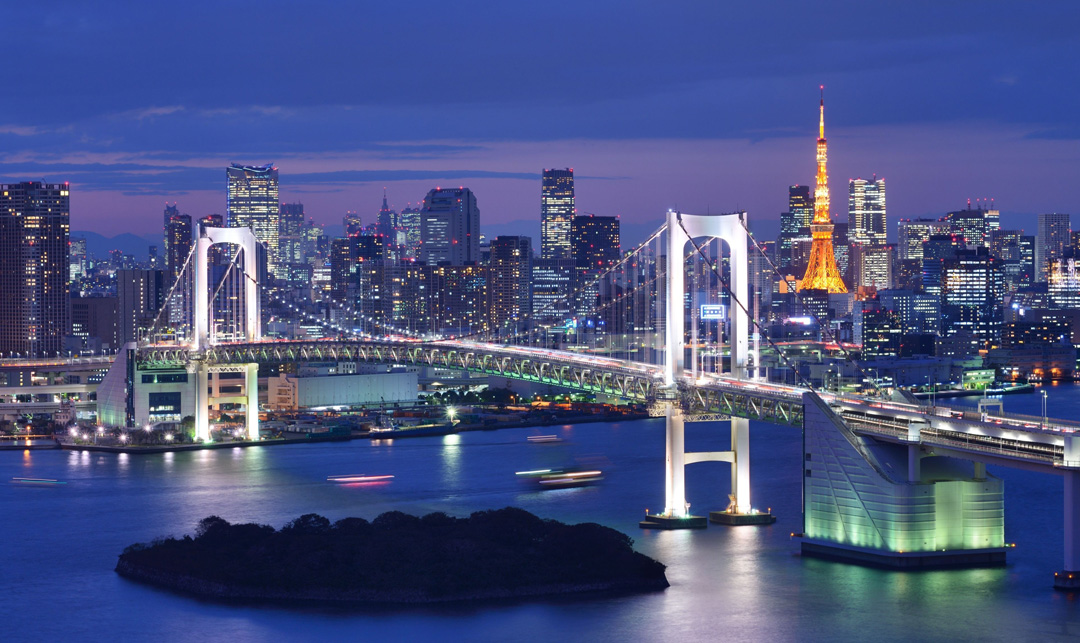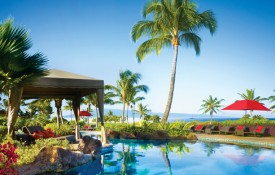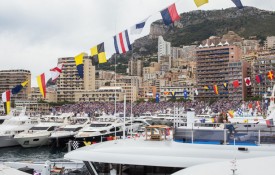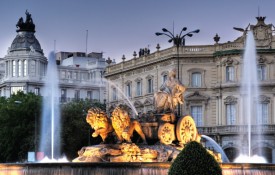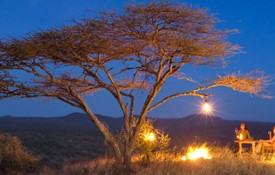Tokyo and Japan are synonymous with technological precision, innovation, work ethic, and the economic strength that’s made the country a powerhouse among nations over the last six decades. Deeper exploration, however, allows Japan’s bustling capital city of Tokyo and quietly majestic Tokushima to present a wonderfully compelling dichotomy of historic and futuristic.
Flying High Over Tokyo
Japanese culture places a high value on hospitality, and it shows up in a variety of settings in Tokyo. There’s the east-meets-west glamour of the Conrad Tokyo, and the Shangri-La Tokyo’s consummate pan-Asian sophistication. In 2015, western business and leisure travelers received a new and unusual lodging option: the Japanese-owned Hoshinoya Tokyo, which fuses the calm of a traditional ryokan (a home-style inn arising in Japan’s Edo period, 1603–1868) and the arty modernity of a boutique hotel.
Travelers can count on the Conrad Tokyo, a part of the Hilton family, for elegant event spaces, spectacular in-house fine dining restaurants (Collage, China Blue and Kazahana), lavish breakfast buffet and menu (the Croque Madame is a revelation), and a wonderfully managed executive club with delicious nibbles from all the restaurants. conradhotels3.hilton.com

The Conrad Hotel, Tokyo
The Shangri-La Hotel remains one of Tokyo’s best addresses. For starters, there’s the location adjoining Tokyo Station, hub of most of the nation’s train lines – including the convenient Yamanote line that runs a loop around the city and stops at essential cultural attractions and neighborhoods such as Ueno Park and the National Gallery, the Meiji Shrine, Harajuku, Ebisu, and Shinjuku. It also straddles the buzzy Yaesu neighborhood and the Marunouchi business district.

Ueno Park in Tokyo
The property is delightfully intimate in its scope and service. The business/concierge desk staff at the Horizon Club work overtime to help guests find various locations around town, decipher Tokyo’s complex street address system, and translate your needs and queries to ensure no appointment gets missed. The Horizon Club’s breakfast and happy hours include a delectable array of champagne, wine and spirits, gourmet nibbles and breakfast (don’t miss their “Royale” take on eggs Benedict with caviar and lobster).
Other Shangri-La amenities include a fully stocked fitness room (including free rental of shoes, swimwear, and clothing), Chi Spa, and marvelous mixology by Jun Okubo. Nadaman Restaurant, a favorite among Japanese executives throughout Japan (a la “Ruth’s Chris”), delivers a truly “locavore-meets-luxury” experience with flavors not watered down for Western palates. Italian anchor restaurant Piacere recently shifted gears with the addition of executive chef Andrea Ferrero, who updated the main dining room menu and added a night-time tapas bar for informal gatherings. shangri-la.com/tokyo

A suite offering at the Shangri-La Hotel Tokyo
Travelers looking to delve into a definitively Japanese hospitality should book a few nights at Hoshinoya Tokyo, a retreat that is both an escape from big-city surroundings and a jumping off point for deeper exploration into Japan. Each floor has its own lounge, and full floor buyouts are available. Guests remove their shoes upon entering the hotel, are served formal tea service at check-in, are encouraged to wear full kimonos, and experience the rooftop onsen (hot springs pools). Breakfast is served in Kaiseki (multi-course) style – a scaled up bento box with beautifully turned out courses. hoshinoyatokyo.com/en
About Town
Hiring a conference interpreter for a corporate gathering is a smart investment. However, a guide who can do that as well as take visitors places beyond the convenient Yamanote line is even better. Our guide, Yukie Nobutsune, brought depth and a local perspective to the Imperial Palace East Garden, Tokyo National Museum, the over-1,000-year-old Narita-san Shinshō-ji Temple, and Asakusa Street. However, she also spirited us through the Tokyo University of the Arts campus into the Yanaka neighborhood (a glimpse of pre-WWII Tokyo interspersed with arty boutiques and antique dealers). The area is also home to the Asakura Choso Museum, a former family home showcasing sculptures, sketches, and photos from the artist and his daughters. Nobutsune also recommended the Sumo Museum and neighboring Edo-Tokyo Museum, concentrating on Edo-era Tokyo history, the performing arts of the time, and the complex structure and culture of the Shogun class.
There’s no shortage of bartending creativity in hotel bars, including Peter Restaurant at the Peninsula Tokyo. However, to impress your colleagues with your bar savvy, you’ll need to whip out your Google Maps to chart out the city’s it-bars. Takuya Itoh and Rogerio Igarashi Vaz are the brains behind Bar Trench and Bar Tram (small-axe.net) in trendy Ebisu, featuring nuanced cocktails deftly blending Eastern and Western spirits and recipes. In Shibuya, Gen Yamamoto (genyamamoto.jp/bar_tokyo) transforms bartending into theater in his reservations-only, eight-seat venue. Codename Mixology (r.goope.jp/spirits-sharing) offers cozy ambiance and wonderful made-to-order and barrel-aged libations in its three locations. Bar Benfiddich is a celebration of whiskey in its many glorious forms, including the new breed of Japanese distillates.
The trick to finding Tokyo’s hidden gems among restaurants is to follow one’s nose to uncover such finds as financial district izakaya Hounen Manpuku (hounenmanpuku.com) and Curry Tsukemen Shuichi (1-9-2 Ebisu-Nishi, Shibuya-ku), where diners can pay in advance at a vending machine. As both the Tokyo address system and some local fare may be intimidating for even the most seasoned traveler, Arigato Japan (arigatojapan.co.jp) has Tokyo (along with Kobe, Kyoto, Osaka, and other cities) covered through its food tours. It also offers cooking classes often booked for memorable team-building activities.

Some of Japan’s hidden beauty can be found outside her city center’s including the Iya Valley in the Tokushima Prefecture
Photo: Elyse Glickman
Getting Back to Japan’s Roots
One way to experience the Okayama, Kagawa, and Tokushima prefectures as the Japanese do is to book at hotels created for the Japanese market. Setouchi Kojima Hotel is a fine choice for foreign execs interested in meeting with central Japanese companies, in a space resembling an ocean liner. The veteran Japanese business/convention property has good food and elevated views of the Seto-Ohashi Bridge, Seto Inland Sea, and Takamatsu City. Smaller groups looking for charm can book a night or two at Tsurugata Ryokan in the Bikan Historical Quarter of Kirashiki. The cultural center of the area is the delightful Ohara Museum of Art, noted for its superb collection of paintings by El Greco, Monet, Matisse, Gauguin, Renoir, and Asian historic and contemporary art.

Seto-Ohashi Bridge
Kirashiki is also the heart of the Japanese denim industry. A block of the historic Bikan quarter is lined with several artfully merchandised jean boutiques. Serious jean connoisseurs shopping for innovative, top-tier pairs can plan a stroll down Kojima Jeans Street. Here, denim flourishes at the shops of Japan’s major denim labels, and trend-setters can get first crack at cutting-edge styles (that also happen to be extraordinarily flattering).
Takamatsu City, the gateway to the Seto Inland Sea, offers ferries to several free-standing island communities that collectively stage the Setouchi Trienniale International Art Festival and individually offer glimpses into Japan’s quiet maritime village lifestyle, unretouched temples, and historic buildings when the festival is not on. While Ogijima Island gained YouTube fame for its cat population, the exquisite Bistro Iori also puts the island on the map. The tiny restaurant reflects the inventiveness of the various Setouchi Trienniale installations in terms of how small spaces can integrate Eastern and Western ideas. You are essentially in the (owner) Maeda family living room, dining on European fare crafted from ingredients harvested steps from the establishment and rooted in Mr. Maeda’s experience as a chef for a top Osaka restaurant.
Once off the return ferry in Takamatsu City, engineering and art buffs should pop into the Miyoshi Lantern Shop. Here, 11th-generation craftsman Masanobu Miyoshi carries on the tradition dating back to 1610 of defying gravity with wood and paper. While watching Miyoshi in action is impressive, his creations demand thorough examination. The fragile, three-layered “Ippon Gake” lanterns are a marvel of physics. The Hotel Hanajukai is also a wonderfully multi-layered delve into exclusively Japanese surroundings. It features suites with private onsens, as well as excellent Kaiseki meals and sake selection.
As the population thins out and the valleys widen, treasures of Japanese history, food culture, and past technological accomplishments reveal themselves. In Mima/Wakimachi, a 17th-century trading center built into a bank of the Yoshino River, much is being done to preserve the houses distinguished by their stately udatsus (originally built as a firewalls between houses) as well as the indigo dyeing craft that drew merchants from all over Japan. Those techniques are today being applied to Japan’s premium denim industry.
As one drives deeper into the mountains of the Iya Valley, the scenery begins to resemble Edo-era screens and paintings. Opportunities for unforgettable hiking trails abound around the Oku-Iya Double Vine Bridges as well as areas surrounding the Obokekyo Mannaka hotel (remodeled rooms have stunning views of the Iya river and décor best described as Japan meeting Finland). Small groups can also refuel at places like Tsuzuki Soba Atelier, where its spirited owner offers classes in how to craft fresh noodle and serves delectables like venison tempura and hand-pressed tofu.
Tougenkyo-Iya Mountain Village, nestled in remote Ochiai, offers Japanese home-style stays at their most calming and sense-stirring. The transformation of eight historic thatched roof farmhouse cottages was accomplished under the direction of American Japanese preservationist and historian Alex Kerr. Kerr and the Chiiori Trust organization focused their attention on restoring structures’ traditional architecture. From there, luxury furnishings, picture windows, luxury bath goods, heated floors, and kitchen appliances were brought in to make a retreat or leisure stay a “heaven on earth.” While there is nary a shop in sight, meals based on requests from visitors at the time of the booking are often full-blown family-style feasts based on centuries-old recipes. Rates run $350 to $500/night, depending on how many people will be staying in a cottage.
Some will prefer the pulse and newness of one of the world’s most dynamic cities, while others will appreciate the calm of rural settings and the collective embrace of nature. Regardless, there is no arguing there’s nothing quite like Japanese culture, where innovation and creativity in their many forms, past and present, never cease to inspire.







































